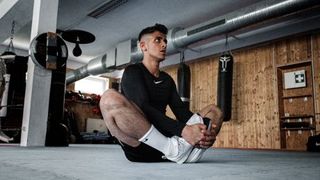Six Ways You Can Train Like A Professional Athlete
Make your training as effective as possible by following the lead set by the elites

It’s not easy to train like a professional athlete if you are not a professional athlete. The main reason being that on top of all your training, you have to do the job you’re actually paid for, whereas pros get to spend their non-training time sleeping and eating as much as they want to instead.
However, you can use the example set by elite sportsmen and women to reshape your own training – to an extent. We asked Jason Reynolds, head of fitness at Lanserhof at The Arts Club, for tips the average athlete can use to maximise their training.
1. Warm Up Properly
Athletes have learned throughout their careers that to perform at their best, they need to get their bodies ready to perform. Most people’s idea of a warm-up is a couple of static stretches, a small amount of cardio and maybe a bit of foam rolling, but if muscles and tendons are not prepared for the movements that are coming, they will not be able to perform to their maximum, which will limit the efficiency of the movement and the effect gained from it. Essentially, if you fail to prepare, you prepare to fail.
2. Train More Than Once Or Twice A Week
Of course it is easier for athletes to train every day because it is their job, but what we can learn from them is that frequency of training not only creates good habits for continued training, but will allow you to challenge various body parts and give them adequate rest and recovery time. Training just once or twice a week makes it difficult to make adaptations in the body, whether you have aesthetic or performance aims.
3. Don’t Go Too Hard Too Often
Modern fitness has a love of all things HIIT. While it has a place in a training plan, it cannot be the only part. Athletes will use high-intensity training periodically to improve cardiovascular function, but not too often because it can increase injury risk and spike stress hormones.
See related
- Train Like An Olympian With These Tips From A Top Coach
- How To Warm Up At The Gym
- How To Avoid Overtraining
4. Master Your Movements
Athletes are great at their chosen sport because they have spent thousands of hours learning and honing their skills. When the average person chooses to train, they often disregard the need to learn or perfect a movement before increasing the resistance or difficulty. If you are unable to move correctly, then as the movement gets harder your training efficiency drops and your performance level will also decrease. The Movement Lab at Lanserhof analyses your functionality, meaning your training is tailored to your body’s individual needs.
5. Work On Your Mentality
Athletes have an ability to dig deep, allowing them to push through the mental barriers that hold back performance when training or competing. You can read stories of plenty of elite athletes using a mental coach to help them find out how to control this, and these methods are available to everyone. Hypnosis, NLP [neuro-linguistic programming] and CBT [cognitive behavioural therapy] have all been shown to help increase performance.
Get the Coach Newsletter
Sign up for workout ideas, training advice, reviews of the latest gear and more.
6. Focus On Recovery
Ever seen a video of some athlete jumping in an ice bath? It looks horrible and uncomfortable! But they do it because they know it will aid their recovery, and allow them to train harder and faster sooner. Ice baths are a little outdated now, but after your next session you could find a cryotherapy chamber that will allow you access -110°C temperatures for a few minutes. It will be an experience you never forget, and you will recover from that day’s training session better than ever before.

Nick Harris-Fry is a journalist who has been covering health and fitness since 2015. Nick is an avid runner, covering 70-110km a week, which gives him ample opportunity to test a wide range of running shoes and running gear. He is also the chief tester for fitness trackers and running watches, treadmills and exercise bikes, and workout headphones.
